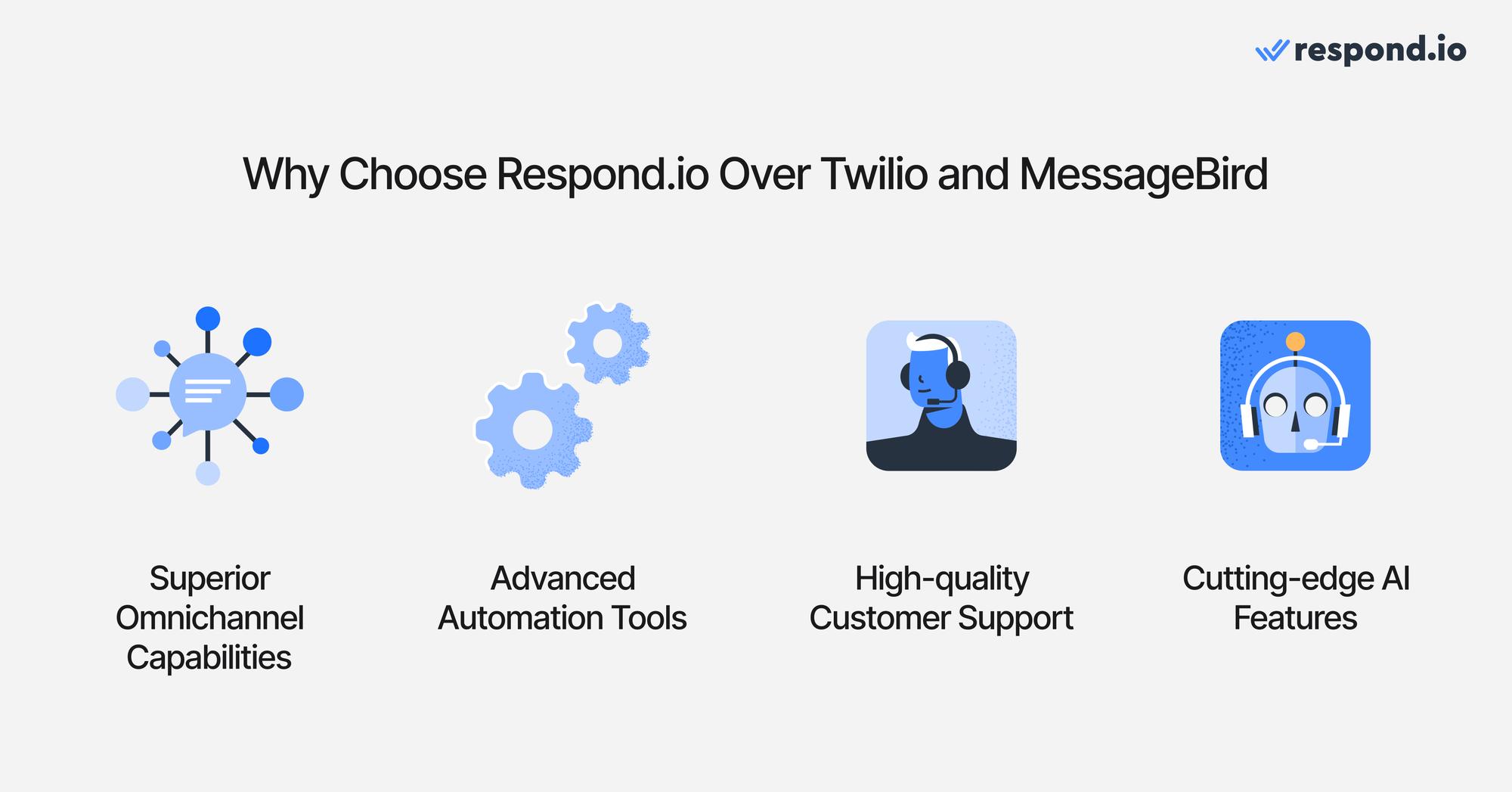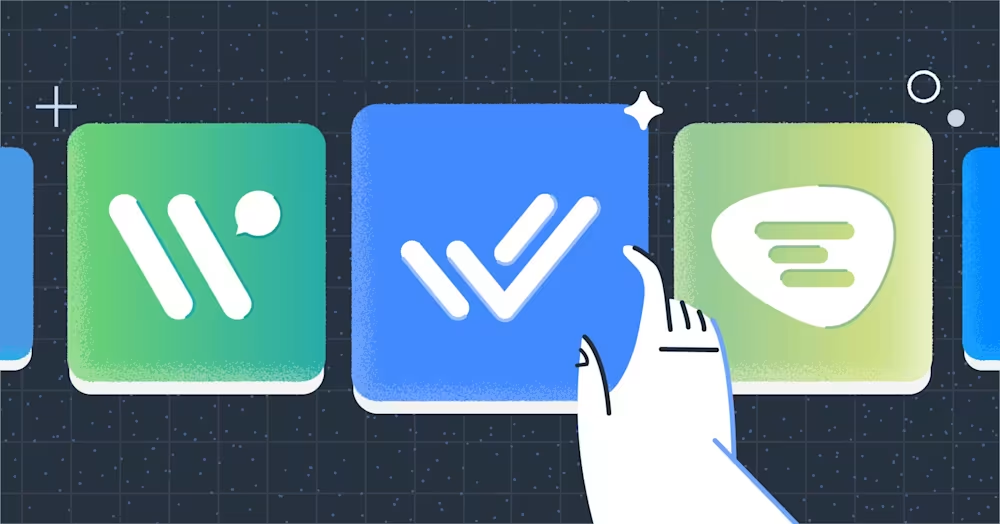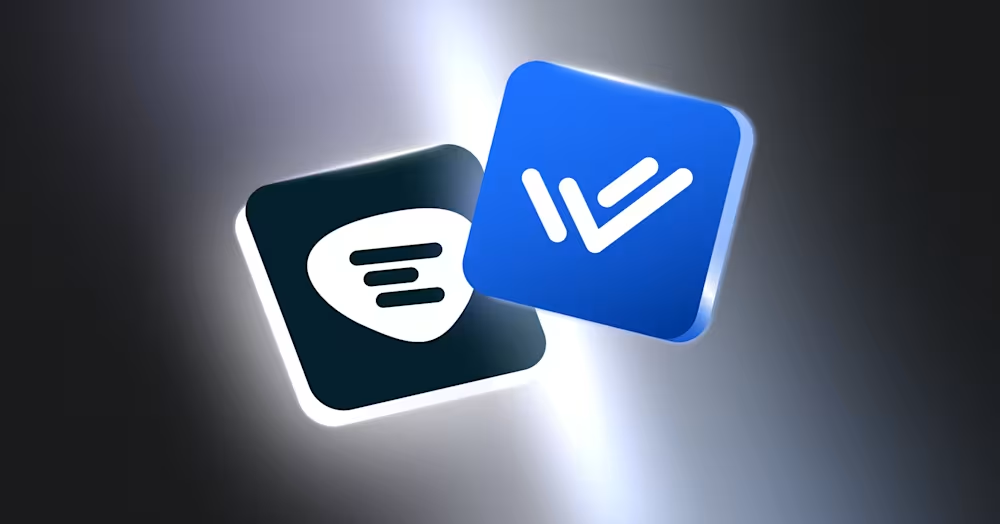Мы понимаем, что нахождение правильного программного обеспечения для управления беседами с клиентами может быть непростым делом при таком количестве доступных вариантов. Трудно сравнить их, когда функции не всегда ясны и технический жаргон еще больше осложняет ситуацию. Вот где мы приходим на помощь. В этой статьей мы сравним Twilio, MessageBird и respond.io, три самых популярных платформы обмена сообщениями. Мы рассмотрим их ключевые функции, цены и ценность, чтобы вы могли сделать обоснованный выбор для вашего бизнеса. Давайте начнем!
Twilio против MessageBird против Respond.io.
Twilio, MessageBird (теперь известный как Bird) и respond.io созданы для управления клиентскими беседами через каналы обмена мгновенными сообщениями и SMS. Тем не менее, способ доставки этих платформ пользователям очень отличается.
Эти платформы идеально подходят для разных случаев использования. Ознакомьтесь с изображением ниже, чтобы получить краткое резюме.
| Twilio | MessageBird | Respond.io |
|---|
Поддерживаемые каналы | СМС, WhatsApp, голосовой вызов. | SMS, WhatsApp, Messenger, Telegram, LINE и электронная почта. | Все популярные каналы, включая WhatsApp, WhatsApp call, Facebook Messenger, Instagram, SMS, Email, Telegram, Viber, LINE и пользовательские каналы |
Многоканальная трансляция | только SMS. | Только SMS и WhatsApp. | WhatsApp, Messenger, LINE, Viber, Telegram, SMS |
Внешние интеграции | Расширенная поддержка интеграции | Расширенная поддержка интеграции | Расширенная поддержка пользовательских API, веб-хуков CRM и популярных сторонних платформ, таких как Zapier и Make. |
Возможности автоматизации | Визуальный конструктор рабочих процессов | Визуальный конструктор рабочих процессов | Расширенный визуальный конструктор рабочих процессов |
Возможности ИИ | AI Agent (только предварительная версия для разработчиков) | Помощник агента, помощник по контенту, помощник по часто задаваемым вопросам | AI-подсказка, AI-помощник и AI-агент |
Клиентская поддержка | Бесплатная и платная поддержка; доступность 24/7 | Хотя сам плагин бесплатен, установка доступна только для пользователей бизнес-плана или плана Pro, а также для пользователей устаревших планов. | Поддержка включена; круглосуточная многоязычная поддержка |
Стабильность платформы | Публичная статистика времени безотказной работы отсутствует | Публичная статистика времени безотказной работы отсутствует | 99.9996% времени безотказной работы |
Представление докладов | Подробная аналитика | Аналитика только по каналам, кампаниям и подписчикам | Расширенные отчеты в режиме реального времени |
Бесплатный план | Доступен бесплатный план с очень ограниченными функциями | Бесплатного плана нет, но предлагается пробная версия | Бесплатного плана нет, но предлагается 7-дневная бесплатная пробная версия |
Начальная цена | N/A (модель оплаты по мере использования) | От 45/мес. | От $79/месяц |
Вот краткое распределение того, что вам нужно знать:
Twilio: Это платформа, предназначенная прежде всего для компаний, которые придают приоритет SMS-коммуникации. Однако из-за технической сложности реализация Twilio часто требует разработчиков, что делает её менее удобной для не технических команд.
MessageBird: она позиционирует себя как решение CRM, направленное на поддержку маркетинговых, сервисных и инженерных команд. Его основная сила заключается в SMS-коммуникации, но она также предлагает интеграции с другими каналами обмена сообщениями, такими как WhatsApp и Messenger. Тем не менее, поскольку основной упор сделан на SMS, она не полностью оптимизирована для компаний, стремящихся к комплексным омниканальным решениям.
Respond.io: Программное обеспечение для управления коммуникацией с клиентами, которое превосходит конкурентов в области продаж и маркетинга через самые популярные мессенджеры. Он известен своей многофункциональностью, надежностью и масштабируемостью, что позволяет компаниям эффективно обрабатывать большие объемы сообщений без сбоев, что делает его идеальным для бесперебойного управления многоканальным взаимодействием с клиентами.
Хотите узнать больше? Продолжайте читать, чтобы узнать, какая из этих платформ лучше всего подходит для вашего бизнеса.
Сравнение функций: Twilio vs MessageBird vs Respond.io
Twilio, MessageBird и respond.io предлагают широкий набор функций для обеспечения взаимодействия с клиентами. В этом разделе мы рассмотрим ключевые функции каждой из платформ, сравнивая их сильные стороны в области обмена сообщениями, автоматизации, омниканальной поддержки и масштабируемости.
Подключение всех ваших каналов в одном месте с помощью омниканальных сообщений.
Омниканальные сообщения позволяют компаниям взаимодействовать с клиентами через различные каналы, включая SMS, социальные сети, электронную почту, мессенджеры и пользовательские каналы, обеспечивая непрерывное и единообразное взаимодействие. Такой подход позволяет компаниям устанавливать связь с аудиторией через предпочитаемые каналы.
Вот некоторые ключевые функции, на которые следует обратить внимание:
Унифицированный почтовый ящик, объединяющий различные каналы, такие как SMS, WhatsApp, Messenger и пользовательские каналы, включая почтовые ящики электронной коммерции.
Интеграция с различными CRM-системами.
Возможность объединения дублирующихся контактных данных.
В совокупности эти функции позволяют командам эффективно управлять всеми взаимодействиями клиентов с одной платформы. Эти возможности позволяют экономить время, уменьшить ошибки и убедиться, что сообщения персонализированы на основе клиента'с полной истории взаимодействия.
| Twilio | MessageBird | Respond.io |
|---|
Доступные каналы | СМС, WhatsApp, Мессенджер | SMS, WhatsApp, Messenger, Instagram, LINE, LinkedIn, электронная почта и голосовые вызовы | SMS, WhatsApp, звонки WhatsApp, Messenger, Instagram, Telegram, LINE, Viber, WeChat, электронная почта, веб-чат и пользовательские каналы |
Интеграция с CRM | Собственная интеграция с Salesforce; создайте собственную интеграцию с другими CRM или интегрируйте через партнера Twilio CRM | Интеграция CRM через Integrations Marketplace | Подключайтесь к таким CRM-системам, как Salesforce и Pipedrive, а также к более чем 1000 другим интеграциям |
Объединить дубликаты контактов | Нет | Ручное слияние контактов | Предложения по автоматическому объединению контактов |
Когда дело доходит до омниканальной рассылки, именно так сравниваются наши три конкурента.
Twilio: Поддерживает SMS, WhatsApp и Messenger, но не пользовательские каналы. Она также обеспечивает интеграцию с Salesforce. Для крупных предприятий с широким присутствием этого обычно недостаточно. Если вы используете другие CRM, вам нужно создать собственную интеграцию или интегрировать CRM с помощью Twilio CRM партнеров. Это также требует ручного слияния повторяющихся контактов.
MessageBird: Предлагает более широкий диапазон каналов, включая SMS, WhatsApp, Messenger, Instagram, LINE, LinkedIn, Email, и голосовой звонок. Тем не менее, он не поддерживает пользовательские каналы. Вы можете подключить CRM через рынок Интеграций. Тем не менее, для автоматического объединения дубликатов контактов у вас не будет возможности, поэтому вам необходимо разрешить дубликаты контактов непосредственно в вашей CRM.
Respond.io: Выделяется самой обширной поддержкой каналов, включая SMS, WhatsApp, Messenger, Instagram, LINE, Telegram, Viber, WeChat, Электронная почта, Веб-чати пользовательские каналы. Он предлагает CRM и другие интеграции через Zapier и Make. Кроме того, предлагает автоматические предложения по объединению контактов, что упрощает управление контактами.
Захватите больше лидов с помощью инструментов роста.
Инструменты для захвата лидов имеют решающее значение для бизнеса, так как позволяют увеличить количество возможностей конвертации потенциальных клиентов. Эти инструменты включают в себя рекламу с кликом для чата, QR-коды и виджеты, все из которых помогают упростить процесс взаимодействия с потенциальными клиентами, собирать их контактную информацию и инициировать разговоры, которые могут привести к конвертации.
| Twilio | MessageBird | Respond.io |
|---|
Доступные каналы | СМС, WhatsApp, Мессенджер | SMS, WhatsApp, Messenger, Instagram, LINE, LinkedIn, электронная почта и голосовые вызовы | SMS, WhatsApp, Messenger, Instagram, Telegram, LINE, Viber, WeChat, электронная почта, веб-чат и пользовательские каналы |
Интеграция с CRM | Собственная интеграция с Salesforce; создайте собственную интеграцию с другими CRM или интегрируйте через партнера Twilio CRM | Интеграция CRM через Integrations Marketplace | Подключайтесь к таким CRM-системам, как Salesforce и Pipedrive, а также к более чем 1000 другим интеграциям |
Объединить дубликаты контактов | Нет | Ручное слияние контактов | Предложения по автоматическому объединению контактов |
Что касается захвата лидов, то это то, что можно ожидать от Twilio, MessageBird и respond.io.
Twilio: Требуется настроить потоки событий для интеграции с кликабельными объявлениями чата. Он также поддерживает QR-коды и предоставляет виджеты, однако поддержка виджетов чата ограничивается веб-чатом – нет других чат-виджетов, специфичных для канала.
MessageBird: Не поддерживает чат-рекламу или QR-коды, но предлагает виджеты, позволяющие бизнесу встраивать формы или интерфейсы чата на своем сайте для захвата лидов.
Respond.io: Обеспечивает надежную интеграцию для кликабельных объявлений чата, гарантируя, что агенты будут в курсе, когда разговоры исходят из этих объявлений. Существует также полная поддержка QR-кодов и омниканального виджета, что делает его эффективным инструментом для захвата лидов через различные каналы и точки касания.
Превратите разговоры клиентов в рост бизнеса с помощью respond.io. ✨
Управляйте звонками, чатами и письмами в одном месте!
Эффективно конвертируйте потенциальных клиентов с помощью автоматизации и ИИ.
Большие предприятия имеют много входящих сообщений для обработки каждый день. Непрактично нанять десятки и даже сотни человеческих агентов для выполнения простых процессов и задач. Здесь на помощь приходят автоматизация и ИИ.
Они могут автоматизировать простые, повторяющиеся задачи, такие как отправка приветствия или сообщения об отсутствии. С помощью ИИ компании могут даже автоматизировать целые процессы, такие как квалификация и распределение лидов, чтобы снизить затраты на менее важные задачи. Это освобождает время человеческих агентов для выполнения более важных задач, таких как завершение продаж.
Ключевые функции, на которые стоит обратить внимание, включают возможности автоматизации, помощников ИИ, агентов ИИ и возможность обучения вашего ИИ на основе источников знаний.
| Twilio | MessageBird | Respond.io |
|---|
Автоматизация без кода | Автоматизатор-строитель | Два разных конструктора автоматизации для обмена сообщениями и процессов | Расширенный конструктор автоматизации |
Помощь ИИ | Нет | Помощник агента, помощник по контенту, помощник по часто задаваемым вопросам | Помощь ИИ Подсказка ИИ |
Агент ИИ | Доступно только разработчикам | Да | Да |
Обучение знаниям в области ИИ | Да | Да | Да |
Давайте посмотрим, как Twilio, MessageBird и respond.io сравниваются по автоматизации и ИИ.
Twilio: Имеет конструктор автоматизации и возможности ИИ. Однако, чтобы использовать помощников Twilio AI, вы должны быть разработчиком и вступить в список ожидания. Сотрудникам не предоставляются инструменты улучшения текста или генерации для ускорения ответов. Хорошая новость заключается в том, что все данные о клиентах используются для обучения ИИ-помощников Twilio.
MessageBird: Есть два вида инструментов автоматизации, один для обмена сообщениями, другой для бизнес-процессов. Чтобы сделать ситуацию более запутанной, существуют три типа инструментов AI Assist, которые существенно улучшают реакцию операторов. Чтобы использовать AI-агента, вам необходимо сначала создать базу знаний, загрузив документы (например, частые вопросы и списки продуктов), настроить его, а затем развернуть.
Respond.io: Основа автоматизации respond.io лежит в разработчике автоматизации рабочих процессов. Он может справиться со всем: от назначения разговоров агентам до квалификации лидов. Вы также можете настроить AI Agent с помощью AI Agent Builder, который позволяет вам создать AI Agent без каких-либо кодов. Агенты получают такие инструменты, как AI Prompt для улучшения их ответа или создания всего сообщения на основе потока разговора. Как и в случае с Twilio и MessageBird, вы можете загружать источники знаний, чтобы улучшить ответы AI-агента.
Сохранение клиентов для повторных продаж с трансляциями
Даже несмотря на то, что предприятия превращают их в платные клиенты, все еще есть больше возможностей. Через трансляцию или массовые сообщения, вы можете получить дополнительные продажи от одного и того же клиента.
Трансляция сообщений является отличным способом продвижения ваших продуктов. И с помощью отчетности и аналитики компании могут узнать, какие кампании лучше всего вкладывать в них дополнительные ресурсы.
| Twilio | MessageBird | Respond.io |
|---|
Поддерживаемые каналы вещания | только смс | СМС и WhatsApp | WhatsApp, Facebook Messenger, SMS, Telegram, Viber, LINE |
Анализ трансляции | Доставка, Неудача | Доставка, прочтения, разбивка по каналам | Доставка, прочтения, сбои, фильтры для конкретных каналов |
Если вы ищете лучший инструмент для рассылки, respond.io не разочарует вас. Вот почему.
Twilio: К сожалению, Twilio поддерживает только широковещательные сообщения на SMS, ограничивая количество возможностей, которые вы можете создать в кампании. В то время как вы можете получить информацию, такую как показатели доставки и отказов в обслуживании, вам необходимо пройти серию высокотехнических шагов для просмотра отчетов.
MessageBird: Это также похоже на Twilio, за исключением предприятий, также можно транслировать на WhatsApp. Компания MessageBird также имеет аналитику, включающую в себя стоимость доставки, стоимость чтения и разбивку по каналам, что позволяет дополнительно фильтровать по диапазонам дат.
Respond.io: Вы можете транслировать на многих каналах, таких как WhatsApp, Instagram, Facebook Messenger, Viber, Telegram, LINE, WeChat и SMS. С помощью модуля Отчетов вы можете получить углубленную аналитику, такую как скорость доставки, чтения и сбоев. Вы также можете фильтровать отчет по каналам и диапазонам дат.
Insights по сообщениям с отчетами и аналитикой.
Обмен сообщениями с клиентами или запуск кампаний недостаточен для роста бизнеса. Им нужны данные для формирования своей будущей стратегии и тактики улучшения.
| Twilio | MessageBird | Respond.io |
|---|
Отслеживание конверсии | Нет | Нет | Да |
Аналитика эффективности агента | Да | Да. | Да |
Пользовательские отчеты и панели мониторинга | Да | Да | Да |
Экспорт данных | Да | Да | Да |
Вот как все три платформы складываются, когда речь заходит о отчетах и аналитике.
Twilio: Нет способа отслеживать конверсии на Twilio. Тем не менее, аналитика эффективности агента доступна через Flex Insights, которая предоставляет гранулярные данные об индивидуальных разговорах и эффективности агентов. Twilio поддерживает пользовательские отчеты и панели, которые могут быть адаптированы к конкретным KPI через Flex Insights панели. Кроме того, поддержка экспорта данных осуществляется через API Twilio, который позволяет экспортировать исторические данные, как записи сообщений, в сжатом формате для дальнейшего анализа.
MessageBird: Хотя нет способа отслеживать конвертации, предприятия могут наблюдать за индивидуальными показателями агентов, как время первого ответа. MessageBird предлагает пользовательские отчеты и панели инструментов, позволяя бизнесу визуализировать ключевые точки данных. Отчеты также могут быть загружены в формате CSV.
Respond.io: Он может отслеживать конверсии с веб-сайтов через Виджет роста. Аналитика эффективности агента очень детальна, предлагая метрики по времени реакции, решениям и работе отдельных агентов с помощью настраиваемых отчетов и панелей инструментов. Кроме того, respond.io позволяет гибкий экспорт данных, поддерживая различные форматы, такие как CSV, и передачу данных в реальном времени на внешние платформы, что делает его оптимальным выбором для бизнеса, который требует полной и осуществимой аналитики.
В списке было много отличных функций. Тем не менее, они могут обрабатывать только разговоры с клиентами. Надежная и дружелюбная платформа также очень важна.
Стабильность платформы и поддержка клиентов.
Представьте: ваш бизнес должен обрабатывать тысячи сообщений каждый день, но ошибки продолжают происходить. Вам нужно две вещи.
Платформа, которая достаточно стабильна, чтобы справляться с вашими операциями.
Отличная команда поддержки клиентов, чтобы помочь с вашими проблемами.
Давайте посмотрим, как эти платформы сопоставляются.
Масштабируемая стабильная платформа.
Компании должны рассматривать стабильность платформы как столь же важную, как и набор функций — отличные функции имеют маленькое значение, если вы не можете постоянно использовать свою платформу большую часть времени.
| Стабильность платформы |
|---|
Twilio | Н/Д |
MessageBird | Н/Д |
Respond.io | 99,9996% времени безотказной работы |
Вот как Twilio, MessageBird и respond.io сравниваются по стабильности платформы.
Twilio: Хотя нет публичной статистики по времени безотказной работы, клиенты сообщают, что Twilio масштабируемая и надежная.
MessageBird: Опять же, нет публичной статистики по времени безотказной работы. К сожалению, MessageBird не предоставляет страницу статуса, что затрудняет отслеживание инцидентов.
Respond.io: Обладая чрезвычайно стабильной и надежной платформой, respond.io имеет 99,9996% времени безотказной работы. Это позволяет компаниям расти без каких-либо ограничений производительности.
Уровень поддержки клиентов.
В конечном итоге каждая компания столкнется с некоторыми проблемами с используемыми услугами. Когда это произойдет, им нужна исключительная поддержка клиентов, чтобы пройти этот трудный период. Высокий уровень поддержки может значительно уменьшить потенциальные потери, с которыми может столкнуться компания в период простоя.
| Часы работы службы поддержки | Многоязычная поддержка | Поддержка включена бесплатно? | Дополнительные сборы |
|---|
Twilio | 24/7 (для бесплатного плана время ответа не гарантировано) | Нет | Да | От 250 долларов в месяц за приоритетную поддержку в чате и по телефону |
MessageBird | 12/5 (Только платная поддержка) | Нет | Нет | От 500$/месяц |
Respond.io | Круглосуточная поддержка в чате | Да | Да | Нет, все планы рассматриваются одинаково. |
Какое решение предлагает наилучшую поддержку клиентов? Мы разберем это для вас.
Twilio: Хотя предлагается круглосуточная поддержка, в рамках бесплатного плана у вас есть доступ только к помощнику AI Help Center. Для приоритетной поддержки и получения доступа к дополнительным каналам, таким как онлайн чат, телефонная поддержка и многое другое вам нужно будет оплатить не менее 250 долларов в месяц.
MessageBird: К сожалению, по умолчанию поддержка пользователей не предоставляется. Предприятия должны оплатить не менее $500 за поддержку клиентов.
Respond.io: Доступно 24 часа в сутки и без дополнительной оплаты с понедельника по пятницу, включая поддержку на английском, арабском, китайском и испанском языках. Компании на более высоких тарифных планах также получают персонального менеджера по успеху клиентов, который поможет вам подключить каналы или настроить автоматизированные алгоритмы для ещё более плавного взаимодействия.
Далее давайте перейдем к самой важной части любого сервиса: ценности.
Максимизируйте каждый доллар, который вы тратите.
Все три платформы имеют очень разные модели ценообразования, что затрудняет их сравнение. Таким образом, в этой секции мы рассмотрим базовые расходы на использование платформы и любые дополнительные затраты, которые могут возникнуть для бизнеса.
| Цена за месяц | Дополнительные сборы | Поддержка | Автоматизация | Дополнительные места в месяц |
|---|
Twilio | - | Тарифы на SMS: 0,0463 долл. США за сообщение Тарифы на WhatsApp: 0,005 долл. США за отправленное и полученное сообщение | Включено | 100 триггеров автоматизации в месяц бесплатно; 0,06 долл. США за триггер автоматизации | $15 |
MessageBird | От 45$ | Тарифы на SMS: 0,0288 долл. США за сообщение Тарифы на WhatsApp: 0,005 долл. США за отправленное сообщение | От 500$ | 1000 бесплатных вызовов в месяц; индивидуальная цена за вызов | $30 (3-10); $27(11-25) |
Respond.io | От $79 | Нет | Включена круглосуточная многоязычная поддержка. | Включено в планы Growth, Advanced и Enterprise | От 12$ |
Если вы ищете краткое резюме, то вот ценность, которую вы получите от Twilio, Messagebird и respond.io.
Twilio: Он предлагает модель оплаты по мере использования, что кажется отличным вариантом, если ваши потребности меняются. Тем не менее, Twilio добавляет надбавку к каждому SMS и сообщению в WhatsApp. Хотя это отлично, если ваша база клиентов малочисленна, для масштабирования это становится очень дорого. Добавление пользователей также обойдется дорого, места стоят 30 долларов на пользователя.
MessageBird: Хотя кажется, что он предлагает очень доступный план, при учете затрат на поддержку и автоматизацию, цена быстро возрастает. Растущему бизнесу или предприятию будет сложно оправдать связанные с этим колоссальные расходы. Это только усугубляется наличием дополнительных мест для пользователей в месяц, что является самым дорогим вариантом среди трех платформ.
Respond.io: Предоставляет прозрачные и конкурентоспособные цены с планами Starter, Growth и Enterprise, и, что еще лучше, без наценок за сообщение. Respond.io предлагает полный набор возможностей даже на плане Старт по цене $79 в месяц. Тем не менее, даже если вы обновите свой план, набор функций и поддержка, доступные для предприятий, позволят вам восстановить ваши инвестиции в кратчайшие сроки.
Итак, теперь, когда вы знаете, как все три платформы складываются, что вы должны выбрать?
Приговор: Почему вы должны выбрать Respond.io.
Respond.io предлагает исключительную ценность для компаний, которые ищут универсальную и масштабируемую платформу обмена сообщениями. Его обширные возможности поддерживают все основные каналы обмена сообщениями, что делает его идеальным для компаний, желающих увеличить продажи и маркетинг.
Благодаря передовым инструментам автоматизации, надежной поддержке клиентов и мощным функциям отчетности и ИИ, упрощает операции respond.io и повышает вовлеченность клиентов в несколько платформ.
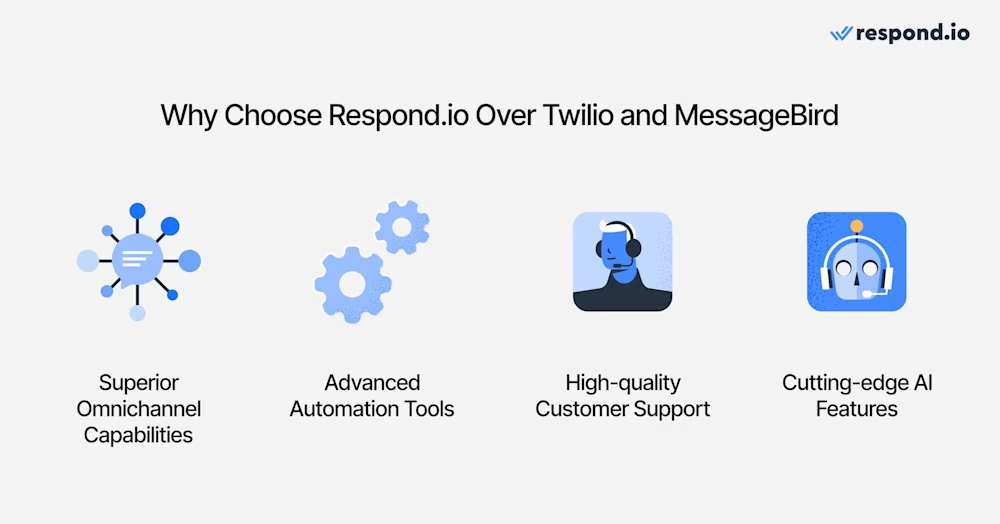
В то время как Twilio и MessageBird являются сильными вариантами, они сосредоточены в первую очередь на SMS и голосовых коммуникациях. Благодаря API для деловых звонков WhatsApp , который теперь доступен во многих странах, таких как Мексика, Сингапур и Великобритания, response.io также предлагает голосовую связь через самое популярное социальное приложение.
Подводя итог, можно сказать, что response.io остается превосходным выбором для компаний, которым нужна комплексная многоканальная платформа обмена сообщениями по конкурентоспособным ценам.
Превратите разговоры клиентов в рост бизнеса с помощью respond.io. ✨
Управляйте звонками, чатами и письмами в одном месте!
Дополнительное чтение.
Вам нравится читать эту статью? Затем проверьте сравнения программ управления разговорами клиентов:
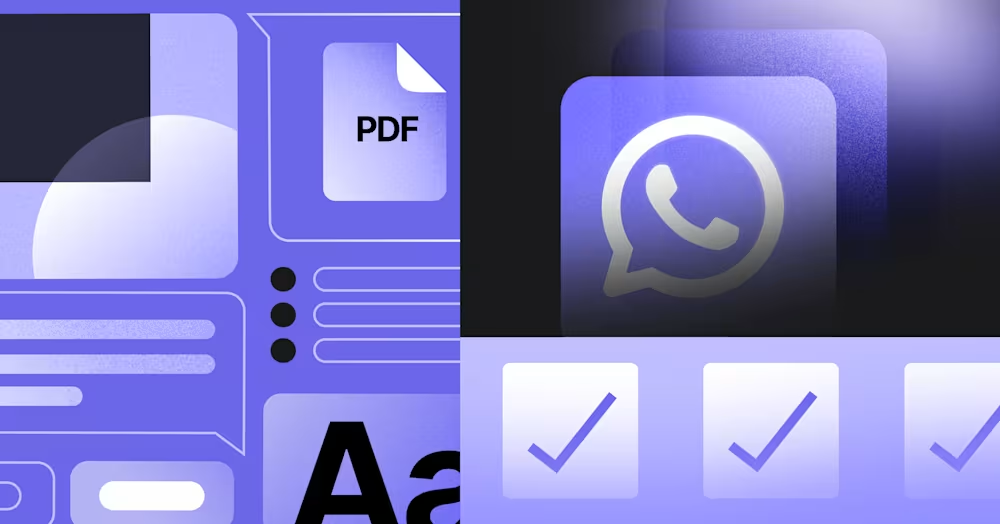



































 Обзор
Обзор Электроника
Электроника Мода и одежда
Мода и одежда Мебель
Мебель Ювелирные изделия
Ювелирные изделия
 Внеурочные занятия
Внеурочные занятия Спорт и фитнес
Спорт и фитнес
 Центр красоты
Центр красоты Стоматологическая клиника
Стоматологическая клиника Медицинская клиника
Медицинская клиника
 Услуги по уборке и няням
Услуги по уборке и няням Фотография и видеосъемка
Фотография и видеосъемка
 Розничная продажа авто запчастей
Розничная продажа авто запчастей Автосалон
Автосалон
 Турагентство и оператор туров
Турагентство и оператор туров


